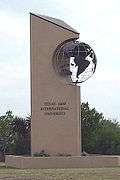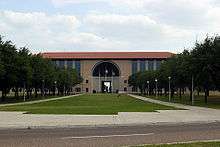Texas A&M International University
 | |
| Type | State university |
|---|---|
| Established | 1969 |
| President | Pablo Arenaz [1] |
Academic staff | 192 Full-time (Fall 2011) |
| Students |
7,408 (Fall 2013) 7,173 (Fall 2012)[2] |
| Location | Laredo, Texas, U.S. |
| Campus | 300 acres (1.2 km²) |
| Nickname | Dustdevils |
| Website |
www |
 | |
Texas A&M International University, often referred to as TAMIU, is a public, co-educational, state-supported university located in Laredo, Texas. The university has a modern campus on a 300-acre (1.2 km2) site in Laredo, Texas. It is a Member of the Texas A&M University System which is one of the largest systems of higher education in the nation. Located in Laredo, Texas, a crossroads of culture and commerce, TAMIU is a major regional educational institution of choices in the State's fastest-growing demographic area and home to over 7500+ students each academic semester. TAMIU offers over 70 undergraduate, graduate or doctoral degrees in the arts and sciences, business administration, and nursing in the four colleges of the University.
The most popular undergraduate majors are business administration, criminal justice, nursing, biology and communication disorders. The top graduate majors are business administration, educational administration, counseling psychology, school counseling and accounting. Of graduate students, 64% hold undergraduate degrees from TAMIU.
History
- 1969: Established as a branch of Texas A&I University at Kingsville, and named Texas A&I University at Laredo, functioning as an upper-level University for juniors, seniors, and graduate students. The Senate bill was introduced by Wayne Connally, brother of Governor John B. Connally, Jr.
- 1977: University's name changes to Laredo State University.
- 1989: University joins The Texas A&M University System.
- 1993: Name changes to Texas A&M International University.
- 1995: An unsuccessful attempt is made to transfer TAMIU to the University of Texas System. TAMIU becomes a four-year University, welcomes its first freshman class and opens its new campus, the first new University campus constructed in Texas in over 25 years.
- 2001: Ray Keck, III, succeeds J. Charles Jennett as university president.
- 2004: Doctoral program in International Business Administration is launched.
- 2006: Early College High School joins TAMIU (in collaboration with Laredo Independent School District).
- 2009: 40th Anniversary Celebration (2009-2010) begins.
- 2010: Dedicates Autism Interventions Center.
- 2010: Dedicates new University Success Center.
- 2011: Dining Center Expansion in Student Center opens.
- 2012: With the approval of The Texas A&M University System Board of Regents, the University Success Center is renamed the Senator Judith Zaffirini Student Success Center. Formal dedication ceremonies are scheduled in September 2012.
- 2014: Enabled by legislation authored by State Senator Judith Zaffirini and approved by the 79th Texas Legislature in 2005, the University announced its historic launch of a University-level academy on its campus for highly gifted and motivated high school seniors, to be known thereafter as The Texas Academy of International and Science, Technology, Engineering and Math (STEM) Studies.[3]
- 2016: Longtime President, Dr. Ray M. Keck III, is named Interim President at Texas A&M University-Commerce. Provost Dr. Pablo Arenaz is named Interim TAMIU President.
Academics
Texas A&M International University offers undergraduate, graduate, and doctoral degrees through four colleges. They include:
- College of Arts and Sciences
Over 35 undergraduate majors, 32 undergraduate minors, and 12 graduate degrees programs in the fine and performing art, sciences, humanities, social sciences, behavioral sciences, mathematics, and engineering are available.
- A. R. Sanchez, Jr. School of Business
- College of Education
- College of Nursing and Health Sciences
The Chronicle of Higher Education named TAMIU among the nation’s fastest-growing public master’s institutions in its “Almanac of Higher Education 2013.” In 2013, Washington Monthly Magazine ranked TAMIU in its Top 5% of national Master’s Universities. College Database named TAMIU Third in the nation among top Colleges and Universities that support Hispanic students. TAMIU was named to the national “2014 Military Friendly List.” TAMIU’s ranking by U.S. News & World Report for its “2014 Best Colleges Rankings” noted the University’s retention rate (71%); Least Class Debt; Large, Need-Based Financial Aid Package and Class Size Fewer than 20 Students. Students scored TAMIU higher than peer institutions and national average responses on the 2013 National Survey of Student Engagement (NSSE). TAMIU initiated dynamic flex scheduling to better accommodate the schedules of undergraduate and graduate students. TAMIU joined the Institute of International Education (IIE)’s “Generation Study Abroad” initiative aimed at doubling the number of students who study abroad. For the first time in history, TAMIU hosted a select group of 36 students from across the nation for the Harvard Kennedy School’s Latino Leadership Initiative.
TAMIU became an approved, certifying organization that can nominate students for The President’s Volunteer Service Award in Fall 2014. TAMIU launched The Texas Academy of International and STEM Studies an innovative, on-campus University-level academy for highly gifted and motivated high school juniors and seniors. TAMIU students ranked the University ranked No. 3 in “Top Mathematics Programs for Financial Aid” and No. 2 in “Top Mathematics Programs for Career Support” on GraduatePrograms.com. This fall, TAMIU implements three new programs: Haven, Green Dot and Safe Zone. All expand its dedication to the student experience by enhancing the learning environment and on-campus safety. TAMIU’s student retention rate is higher than state, national norms according to the Texas Higher Education Coordinating Board’s Accountability System. The retention rate for students remaining in higher education is almost 87%, among the highest of The Texas A&M University System’s regional campuses. The retention rate for returning students remaining at TAMIU is 74.10%.
For the second year in a row, The Chronicle of Higher Education named TAMIU among the nation’s fastest-growing public master’s institutions, ranking it No. 8 in its “Almanac of Higher Education 2014.”
Rankings
According to U.S. News & World Report in “2015 Best College Rankings” TAMIU has been moved up and ranked No. 20 in Top Public Regional Universities, West, and in 2014 TAMIU's rank was 35th. TAMIU's A. R. Sanchez Jr. School of Business ranks as the second best in the country for providing the "Greatest Opportunity for Minority Students."[4] As of 2010, the A.R. Sanchez Jr. School of Business doctoral degree in International Business is the only fully locally offered (non-collaborative) doctoral degree offered by the University.
The Princeton Review named the A.R. Sanchez The School of Business a “Best Business School” in its 2006 and 2008 editions. The 2008 edition of The Princeton Review also listed the School as a Top Ten for Business Schools offering the greatest opportunity for minority students.
In 2013, the National Council on Teacher Quality, based in Washington, D.C., ranked TAMIU subpar in the matriculation of its education majors, of which there were some seven hundred graduates between 2009 and 2012. The institution received 2.5 on an 8.0 ranking system, or 1.5 for its elementary program and 1.0 for the secondary studies. TAMIU provides the majority of public school teachers to the two systems in Webb County. The programs were evaluated based on rigor, selectivity, and the level of mentorship provided to prospective educators.[5]
TAMIU officials questioned the motive, methodology, and results of the study. University officials released a statement: "TAMIU joins other teacher-training programs from colleges of education across the nation in challenging the accuracy of NCTQ results that incorporate inaccurate data and inherently flawed research methodology."[6] The NCTQ was founded in 2000 by the conservative think tank, the Thomas B. Fordham Institute. TAMIU suggested that the NCTQ favors the dismantling of university teacher education programs with "bargain-basement on-line programs, some of which are directed by NCTQ surrogates."[6] TAMIU questioned why no NCTQ researcher visited the campus but instead based its evaluation on information sent primarily to the Washington office via emails.[6]
The TAMIU program was placed on probation in February 2013 by the Texas Board of Educator Certification. Though 70 percent of the TAMIU education graduates passed the certification examination, state accountability standards require an 80 percent completion rate to avoid the probationary status.[6] TAMIU President Ray Keck noted that Texas Tech, Rutgers, Syracuse, and Stanford universities all fared poorly in the NCTQ study as well and asked, "Do you honestly believe those universities run slipshod programs in education?"[6] In July 2014, the University was notified by the State Board for Educator Certification (SBEC) that its full accreditation status had been restored.[7]
On 7.1.14, according to the College Affordability and Transparency Center, a project of the U.S. Department of Education, the University ranked sixth in the nation for lowest net price among public four-year universities.[8]
Research
TAMIU is home to various research centers, including the Binational Center, Center for the Study of Western Hemispheric Trade, The Western Hemispheric Trade Information Center, the Texas Center for Border Economics and Enterprise Development, the Small Business Development Center and the Center for Earth and Environmental Studies.
Benefactors
One of the institution's largest private benefactors was Radcliffe Killam (1910-2007), a Laredo oilman who donated $2 million to establish The Center for Western Hemispheric Trade, in addition to the University's 300-acre (1.2 km2) campus land. Killam and his wife, the former Sue Spivey, were honored by TAMIU with honorary doctorates and the naming of the Radcliffe and Sue Killam Library.
Athletics
TAMIU's 11 sports teams are known as the Dustdevils and compete in the Heartland Conference. They became active members of NCAA Division II on September 1, 2008. As an active member, TAMIU is eligible for conference championships and NCAA tournament berths.[9]
TAMIU participates in the following sports:
- Baseball
- Men's Basketball (2010 and 2013 Heartland Conference Tournament Championship)
- Women's Basketball (2013 Heartland Conference Champions)
- Cross Country
- Men's Golf
- Women's Golf
- Men's Soccer (2003 Red River Athletic Conference Champions, 2010 Heartland Conference Title)
- Women's Soccer
- Women's Volleyball (2002 West Division Athletics Conference Champions)
- Softball (2010 Heartland Conference Tournament Championship)
In August, 2014, the Dustdevil Athletics Department launched a new team logo and marks for the NCAA Division II programs.
Student Fee Changes, Fixes
Student fees at TAMIU increased by 7 percent in the 2011-2012 academic year. A 30 semester-hour course load increased in costs from $6,122 to $6,588, or $455. The additional fees were earmarked for library, parking, technology access, energy costs, athletics, graduate application fees, and a new student scholarship program.
In 2011-2012, TAMIU had the 11th-lowest tuition rate among public four-year universities in Texas, according to the United States Department of Education. After considering scholarships and grants, for which 95 percent of the students can qualify, TAMIU is ranked the fourth-most affordable university in Texas.[10]
In Fall 2014, the University launched a Fixed Tuition and Fee Plan as mandated by The Texas A&M University System Board of Regents, effectively guaranteeing the Texas resident undergraduate tuition and fees for four years for most majors for 12 consecutive semesters.[11]
Notable alumni
- Esther Buckley, member of the United States Commission on Civil Rights, 1983-1992; Laredo educator
- Henry Cuellar, member of the United States House of Representatives since 2005
- Rodney Lewis, American oil and natural gas industrialist, graduated from TAMIU with degree in criminal justice
- Juan Perez, Wisconsin politician
- Dr. Robert F. Thomas (Class of 2000), Chief Executive Officer, Big Bend Area Health Education Center and Rural Health Networks, Tallahassee, Florida
- Tano Tijerina (Class of 2001), former pitcher for minor-league teams of the Milwaukee Brewers, incoming County Judge of Webb County[12]
Notable faculty
- Janet Krueger, retired art professor and artist of south Texas ranching life
- Ned Kock, information systems professor and human evolution theorist
- Rafael A. Lecuona, former Olympic gymnast and late political science professor
- Jerry D. Thompson, historian and award-winning author of multiple books on the American Southwest
Gallery
 TAMIU entrance sign
TAMIU entrance sign TAMIU Student Center
TAMIU Student Center TAMIU Center for the Fine and Performing Arts
TAMIU Center for the Fine and Performing Arts TAMIU fountain is an homage to the acequia.
TAMIU fountain is an homage to the acequia. Texas A&M International University's Sue and Radcliffe Killam Library
Texas A&M International University's Sue and Radcliffe Killam Library- Western Hemispheric Trade Center at TAMIU
- Dr. F. M. Canseco Hall
- Dr. Billy F. Cowart Hall is named for the former president Billy Cowart, who headed the institution from 1969 to 1985
- The Lamar Bruni Vergara Science Center and Planetarium
 Lamar Bruni Vergara Science Center
Lamar Bruni Vergara Science Center TAMIU Lamar Bruni Vergara Memorial Garden
TAMIU Lamar Bruni Vergara Memorial Garden Lamar Bruni Vergara Science Center
Lamar Bruni Vergara Science Center
References
- ↑
- ↑ Cody Permenter, "Fewer Students: Stats: LCC's enrollment figures show drop of 1,300 in 5 years", [TAMIU up 3.28 percent over 2012] Laredo Morning Times, October 22, 2013, p. 1
- ↑ https://www.tamiu.edu/newsinfo/newsarticles/2014-TexasAcademy042114.shtml
- ↑ "Best 282 Business Schools". The Princeton Review. Archived from the original on 2006-12-12. Retrieved 2007-01-06.
- ↑ JJ Velasquez, "Study slams TAMIU: Grads not prepared to teach", Laredo Morning Times, June 19, 2013, pp. 1, 14A
- 1 2 3 4 5 JJ Velasquez, "Study challenged: TAMIU responds to teacher preparation issue", Laredo Morning Times, June 20, 2013, p. 1
- ↑ https://www.tamiu.edu/newsinfo/newsarticles/2014-COEDAccreditation061914.shtml
- ↑ http://collegecost.ed.gov/catc/
- ↑ "TAMIU Athletics Granted Active NCAA Division II Status".
- ↑ JJ Velasquez, "Paying Tuition: Statistics: TAMIU, LCC easier to pay for", Laredo Morning Times, July 15, 2013, pp. 1, 12A
- ↑ https://www.tamiu.edu/fixedtuition/
- ↑ "Meet Tano". tanoforcountyjudge.com. Retrieved April 27, 2014.
External links
| Wikimedia Commons has media related to Texas A&M International University. |
Coordinates: 27°34′22″N 99°26′07″W / 27.5727°N 99.4353°W
